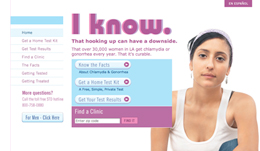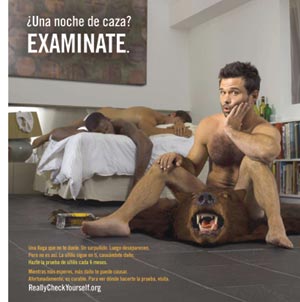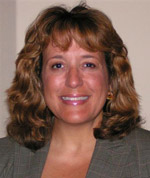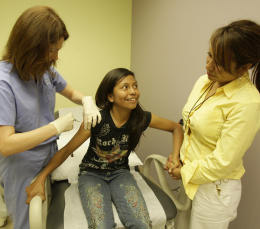Public Health
Answering the cry for help—now in Spanish
December 15, 2009
 Suicide is a universal problem—but when it comes to crisis help lines, suicide prevention is far from an international language.
Suicide is a universal problem—but when it comes to crisis help lines, suicide prevention is far from an international language.
That’s about to change as Didi Hirsch Mental Health Services, the Westside’s biggest mental health service provider, begins offering extensive Spanish-language coverage on its 24-hour crisis line this week.
“We know they are eager for help,” said Kita S. Curry, Didi Hirsch’s president and CEO. “Calls to our hotline more than double whenever La Opinion or various Spanish language radio and TV stations report on our services.”
Didi Hirsch will become one of only 11 centers in the U.S. offering 40 hours or more of Spanish language coverage each week, said Lidia S. Bernik, director of network development for the National Suicide Prevention Lifeline, an organization dedicated to maintaining high standards among members of its network.
The Board of Supervisors on Dec. 1 approved a change in the county’s contract with the center, allowing it to receive $802,733 in state Mental Health Services Act funds, with part of the money going toward establishing the Spanish-language lines. Already five bilingual crisis counselors have been hired and the organization is searching for a bilingual therapist. The center also is looking for volunteers to complete its intensive training program so they, too, can answer the hotline—a challenge for many bilingual working people who can’t easily miss job or family obligations to take part in the 60-hour course. (The next volunteer training sessions begin Jan. 23.)
“There are few events that are more shattering for a family than a suicide. The ability to prevent one affects many lives,” said Marvin Southard, the county’s director of mental health, explaining the importance of offering Spanish language crisis-line services. Southard said the benefits will ripple beyond Los Angeles because the organization serves as a backup for other suicide hotlines throughout California, picking up their calls when they are over-subscribed, he said.
While the center has had limited Spanish language coverage—and has access to a network of speakers of languages including Korean and Farsi as well as Spanish, German and French—the center will expand its reach dramatically starting on Wednesday. That’s when it will begin offering callers help in Spanish from 8:30 a.m. to 12:30 a.m. Once new hires are trained, the service will run round-the-clock. The number for the center’s crisis line is (877) 7-CRISIS, or (877) 727-4747.
The need for outreach and prevention is profound.
Although Latinos in general do not commit suicide at a rate greater than whites, Latino young people, especially teenage girls, are more likely than their peers in other ethnic groups to consider and attempt suicide.
A 2007 CDC survey of risky behavior among high school students found that 21.1% percent of Latinas reported they had seriously considered attempting suicide, compared to 18% of black females and 17.8% of whites. An earlier CDC report, “Suicide Among Hispanics,” said that suicide was the third-leading cause of death among Latinos ages 10-24.
“Hispanics in grades 9-12, particularly females, report more feelings of sadness or hopelessness and of suicidal ideation and attempt, compared with their white or black non-Hispanic counterparts,” the report said. “A comprehensive, strategic plan for suicide prevention should include multiple points for prevention, maximizing the likelihood of reaching persons in need.”
In all, 675 people committed suicide during 2007 in Los Angeles County. Most of them—58%–were non-Hispanic whites, while 22.5% were Latinos, followed by Asians, blacks, Native Americans and Pacific Islanders.
In addition to helping to establish Spanish crisis lines, the new mental health funds also will be used by Didi Hirsch to create support groups for Spanish-speaking survivors of suicide and to expand the organization’s outreach capacity to Latinos in both English and Spanish. A key target of that outreach will be focused on high schools, where Latino students are an important audience for suicide prevention messages, said Lyn Morris, Didi Hirsch’s division director of emergency services.
Along those lines, the county Department of Mental Health also is planning a targeted program aimed at suicide prevention among teenage Latinas, which is expected to come before the Board of Supervisors early next year.
Such multi-faceted efforts are crucial. Morris of the Didi Hirsch center said Latinos tend to rely on “internal support systems” such as friends and family and church, generally turning to outsiders only as a last resort.
“By the time they call us,” she said, “we find that they’re pretty desperate.”
Thanks for not sharing
October 15, 2009
Jorge Montoya knew he was no longer in the private sector, brainstorming marketing strategies with the likes of Fox, Paramount and Yahoo.
Hired in 2002 by L.A. County’s Public Health Department to help run its sexually transmitted diseases program, Montoya says he found himself surrounded by nurses and doctors who looked at him “like a crazy man” as he preached the gospel of product branding, social marketing and behavioral research.
Montoya says his new government colleagues simply hadn’t been exposed to the kind of cutting-edge techniques that the county would need to crash through the media clutter and reach its targeted audiences.
“We’ve come along way,” he says. “There’s been a lot of learning.”
Today, those seemingly exotic marketing methods infuse every aspect of the county’s multi-faceted campaign to reduce the region’s high rate of STDs, especially among the high-risk populations of gay men and young women of color. By all accounts, the county’s effort has emerged as one of most innovative and far-reaching in the nation.
 The newest addition to the campaign— www. dontthinkknow.org, a website where women can confidentially order home test kits for chlamydia and gonorrhea—already is producing promising results, potentially saving women from infertility and other long term health affects associated with untreated STDs.
The newest addition to the campaign— www. dontthinkknow.org, a website where women can confidentially order home test kits for chlamydia and gonorrhea—already is producing promising results, potentially saving women from infertility and other long term health affects associated with untreated STDs.
In the first three months after the site’s June launch, nearly 2,000 kits were requested, with about half of them returned to the county for testing. Of those, health officials say, about nine percent came back positive for chlamydia and/or gonorrhea. Nearly 90 percent of the infected women, Montoya says, have sought treatment—a good number, he says, but not good enough. “We want 100 percent and we won’t rest until we get there,” he vows.
Under the direction of the Board of Supervisors, the Public Health Department revamped and intensified its STD prevention program in late 2006, as infections in the county ranked among the highest in the U.S. Particularly alarming was the fact that syphilis, after leveling off for several years, had started soaring again.
Dr. Peter Kerndt, director of public health’s STD program and Montoya’s boss, says that the success of HIV medications had brought an unintended consequence. “There were a whole lot of gay men who were feeling good and they returned to some of the same old risky behaviors,” Kerndt says. “They were getting syphilis and gonorrhea and chlamydia and infecting others.”
This was especially worrisome, he says, because those infected with syphilis are up to five times more likely to pass the HIV virus to partners.
To turn the tide, two distinct campaigns were created through a contract with Fraser Communications, a Los Angeles advertising and marketing firm that handles a mix of public and private sector clients.
 One campaign, called “I Know,” is targeted at young black and Latina women, who have disproportionately high rates of chlamydia and gonorrhea. The other, dubbed “Check Yourself,” urges gay and bisexual men to get tested for syphilis. In both cases, the idea behind the marketing strategy was to create a sense among the targeted audiences that “whoever is talking to me understands my emotions and my drives,” according to Fraser account director Dean Stephens.
One campaign, called “I Know,” is targeted at young black and Latina women, who have disproportionately high rates of chlamydia and gonorrhea. The other, dubbed “Check Yourself,” urges gay and bisexual men to get tested for syphilis. In both cases, the idea behind the marketing strategy was to create a sense among the targeted audiences that “whoever is talking to me understands my emotions and my drives,” according to Fraser account director Dean Stephens.
Supervisor Zev Yaroslavsky provided a crucial infusion of $700,000 from Third District funds to underwrite the inaugural media efforts of the two campaigns. He would later provide an equal amount for both the second and third years.
Among other things, the money paid for a social marketing campaign that has included ads in magazines and on billboards, bus shelters and niche websites. Tens of thousands of posters and postcards have been placed in South L.A. hair and nail salons as part of the “I Know” campaign. The “Check Yourself” effort has included advertising slides in movie theaters and the distribution of more than 100,000 coffee cup sleeves and 76,000 bar coasters in West Hollywood and other targeted neighborhoods.
Outreach teams, meanwhile, have taken to the streets in communities with the highest infection rates, handing out thousands of “palm cards,” as well as lip balm and condom key chains paid for by the non-profit California Family Health Council.
As a result, Montoya says, there has been a “significant association” between women who’ve been exposed to the “I Know” campaign and those who’ve sought testing and treatment. As for the men, they’re more problematic. “They’re easier to reach,” Montoya says, “but harder to motivate.”
Gay men have been bombarded with so many health messages for so long that they’ve become fatigued and desensitized to them, he says.
 So the county’s approach for the “Check Yourself” campaign was to come up with clever, provocative images with new kinds of messages to hopefully inspire men to act. As Fraser account director Stephens put it: “We purposely decided we would not be shy. You can’t deny that people do respond to sexually charged ads.”
So the county’s approach for the “Check Yourself” campaign was to come up with clever, provocative images with new kinds of messages to hopefully inspire men to act. As Fraser account director Stephens put it: “We purposely decided we would not be shy. You can’t deny that people do respond to sexually charged ads.”
The latest round of print ads, which were tested with focus groups, are certainly risqué by government norms. They show men, barely covered, in a series of witty morning-after scenarios, including one in which a man is wearing only an inflatable rubber duck around his hips as he tip-toes across a pool deck. In the background, several nude men are sleepily sprawled across lounges. The headline: “Check Yourself: You can’t escape the night before.”
Fraser’s research shows that, despite an extremely competitive landscape, the ads have grabbed the attention of more than 80 percent of gay men surveyed by the firm. Fraser and the county are now evaluating whether that awareness has translated into more tests.
“Can we change behavior?” asks Montoya. “That’s the challenge.”
Merck no match for L.A. County pharmacy director
May 5, 2009
L.A County Pharmacy Director Amy Gutierrez was determined to make pharmaceutical giant Merck & Co. live by its corporate motto: “Where patients come first.”
Merck, she says, was balking at providing free doses of the cervical cancer vaccine Gardasil to uninsured young women no longer eligible to receive the drug through a state administered program.
Gardasil, which has proven to be about 75% effective in preventing cervical cancer, is recommended for women between the ages of 9 and 26. But California offers free vaccines to uninsured women only up to the age of 18. Gutierrez wanted to make sure that no woman would be denied the vaccine because of her age or insurance status.
Merck executives saw it differently.

L.A County Pharmacy Director Amy Gutierrez
“It was an arbitrary decision that I thought was insulting,” says Gutierrez, who’s headed the pharmacy for three years.
Last summer, Gutierrez began pushing Merck hard on the phone and in writing, with help from Dr. Robert Israel, an OB-GYN who oversees women’s health clinics at LAC+USC medical center. She also enlisted the interim chief medical officer of the county’s health services department, Dr. Robert G. Splawn.
In July, the two co-signed a sharply worded letter to Merck, explaining once again the importance of providing Gardasil to uninsured and vulnerable women between the ages of 19 and 26 at county medical facilities. Denying the vaccine to these patients simply because they’re being seen in a public hospital or clinic, they wrote, “is not logical, nor is it consistent with the stated objectives” of Merck’s patient assistance program, to provide vaccines to those who can’t pay.
Not so subtly, the two also reminded Merck that Los Angeles County is a big customer, spending more than $9 million annually on the company’s various drugs.
Still, Merck held fast to its position, saying it was waiting for the results of a pilot program with public agencies in several states before proceeding, a program for which California had not applied. So Gutierrez and her staff decided to turn up the heat, making Merck aware that the county had begun scrutinizing certain big-ticket purchases from the company.
Concerned by the county’s move, Merck executives called to discuss the situation. But the pharmacy director says she told them: “There’s only one item on the agenda that I want to talk about.”
One month later, in mid-December, Gutierrez says she got “a great Christmas present”—an e-mail from a top Merck executive.
“Hello Dr. Gutierrez,” the note began, “I wanted to confirm that we have altered our policy such that public institutions and entities are now eligible to utilize the current Vaccine Patient Assistance Program in the same manner and to the same extent as private institutions and entities.”
Merck’s dramatic shift in policy was not only good news for Los Angeles County but for every county in the U.S., where the vaccine and other designated drugs can now be distributed through public hospitals and clinics.
“I never thought I could do something to change the policy,” says Gutierrez, whose three daughters have all been vaccinated with Gardasil. “But if you have enough persistence, you can pull it off.”
 In February, the county started administering Gardasil through the LAC+USC Healthcare Networks. Dr. Israel, the women’s health expert and a USC professor, says dosages are being provided to about 25 women a month. In the weeks ahead, he says, other county facilities, such as Olive View Hospital, will begin the vaccination program.
In February, the county started administering Gardasil through the LAC+USC Healthcare Networks. Dr. Israel, the women’s health expert and a USC professor, says dosages are being provided to about 25 women a month. In the weeks ahead, he says, other county facilities, such as Olive View Hospital, will begin the vaccination program.
Even then, however, he does not expect the numbers of participants to be large because, for the most part, women between the ages of 19 and 26 who show up at county facilities with gynecological issues already are confronting serious medical problems. For them, he says, the vaccine is down the list of priorities.
“We opened the door,” he says of the vaccine’s availability. “I didn’t expect we were going to kick the door down.”
Health professionals hope that, in the future, there’ll be no need to provide Gardasil in this older age group. The goal, they say, is for the vaccine to be administered to all girls at an early age, before they have sexual intercourse and become vulnerable to strains of the human papilloma virus that cause cervical cancer.
Until then, Gutierrez says, she’ll continue to spread the word. “If we can in any way impact cervical cancer in L.A., we’ve succeeded.”

















 405 bridge work causes a stink
405 bridge work causes a stink
